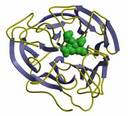|
The Public Health Agency of Canada has decided to add amantadine to its stockpile of anti-viral drugs.
Amantadine has been shown to be impotent against H5N1, but nevertheless, the reasoning behind the decision is sound. The Agency’s Dr. David-Butler-Jones believes it is “prudent to add amantadine to the stockpile as well, because the strain that eventually triggers the next pandemic could be an entirely different strain of influenza or a hybrid of the current H5N1 that is susceptible to the drug.”
Canada has already announced they intended to stockpile $24 million of oseltamivir, which has been shown to be effective against avian influenza.
The U.S. has announced no plans to stockpile amantadine, and currently has on hand 4 million doeses of oseltamivir.
Recombinomics Commentary
February 23, 2005
Pandemic Influenza Antiviral Stockpile Myth
http://www.itv.com/news/britain_2043504.html
Flu drugs stockpiled for key workers
7.24PM, Wed Feb 23 2005
Key workers including police and firefighters could be in line for protection from potentially deadly bird flu.
Tens of thousands of doses of flu vaccine are to be stockpiled ready to be given to the people the country needs most if an outbreak were to take hold.
London Mayor Ken Livingstone announced that £1 million has already been spent on anti-viral drugs to protect up to 100,000 workers in the capital.
This includes police officers, transport workers and firefighters.
The deal for the drug Tamiflu, produced by Roche, aims to secure London's vital services and economy in the event of a pandemic. <<
Although there has been considerable discussion about governments stockpiling anti-virals for use to help control a flu pandemic and keep vital services and health care functional, some analysis of the availability and efficacy is useful. Most of the current focus on a pandemic flu centers on the H5N1 bird flu in Vietnam and Thailand, H5N1has become endemic to the region, which has accounted for all of the reported human cases for the past year. The case fatality rate for the virus is in the 70-80% range and the virus has been expanding its host range and tissue tropism. Another candidate pandemic strain is one that has apparently escaped from a lab an has infected swine in Korea. Two recent isolates are H1N1 and 7 of its 8 genes are from the human lab virus WSN/33.
The are four antivirals that are FDA approved for treating and / or preventing influenza. Two of the drugs, amantadine and rimantadine are ion channel blockers that target the M2 gene product. However, the H5N1 isolates from Vietnam and Thailand have two mutations in the M2 proteins that make H5N1 resistant to both drugs. Similarly WSN/33 and the two H1N1 isolates from swine have a mutation in the gene also that makes the virus resitant.
Thus, the two most likely candidates to spark a flu pandemic are resistant to two of the four approved antivirals. The remaining two antivirals target the neuraminidase gene. However, both viruses listed above also have mutations in the nuramindase gene. H5N1 has a 20 amino acid deletion and WSN/33 and the two isolates in swine in Korea have a 16 amino acid deletion. In addition, all three H1N1 isolates are missing a glycosylation which allow the virus to sequestor plasminogen, which is used to cleave the Heagglutinnin protein to gain entry into cells. Thus, like H5N1, the WSN/33 related isolates have genetic alterations that can be used to expand tissue tropism.
Of the two antivirals that target NA, oseltamivir (Tamiflu) and zanamivir (Relenza), only Tamiflu is available in pill form. Relenza is a nasal spray and only available in limited quantities. Therefore most pandemic flu antiviral stockpilers have focused on Tamiflu.
Although Tamiflu has been used to treat H5N1 patients, the number treated has been low, and many were treated after the recommended time period, which is within 48 hours of symptoms. For the latest H5N1 patients in southern Vietnam, there were no reported discharges, so all died regardless of when they started taking Tamiflu.
Tamiflu targets NA, but is more effective against some subtypes than other. In an earlier screening, Tamiflu was tested against all 9 NA subtypes. Each subtype was represented by 2 avian isolates. N2 was the subtype requiring least amount of Tamiflu to inhibit 50% of the virus in tissue culture. The two most likely pandemic strains are both N1 . N1 inhibition required 8-12 times as much drug to achieve the same inhibition of N2 subtypes. Recently, Tamiflu was tested against H5N1 isolates from Vietnam and Thailand and another 3 fold increase was requited. Thus to achieve the same level of inhibition for N2 requires about 30X as much Tamiflu for H5N1.
Tamiflu was used in vivo in an effort to save tigers at a Thailand zoo. The zoo housed 441 tigers and some were fed H5N1 infected chickens. Initially only 3 or 4 tigers showed symptoms, but the number increased each day. Those that had not been fed chickens were segregated away for the exposed chickens. Several days after the initial deaths more tigers became ill. The tigers were treated with Tamiflu, but eventually 45 tigers died and 102 were euthanized for humanitarian reasons. Thus, in spite of Tamiflu treatment, 33% of the entire population died, but this could have been close to 100% of the infected population.
The recommended adult dose of Tamiflu for prevention is 1 pill per day. Since first responders, doctors, and nurses would be caring for patients over an extended time period in a pandemic, it would seem that each would require at least a months supply or 30 pills (assuming the recommended dose for human influenza would be sufficient for protection against a pandemic flu).
The production rate for Tamiflu had been at about 1.5 million doses per year. Production is being increased to 4 million doses, so if 3 million doses were available, that would be enough antiviral to protect100,000 people for a month. However, the 100,000 would be for the entire world, not just London.
Many cities and countries have made announcements on stockpiled doses. These announcement are much higher than the projected production of Tamiflu, which would protect 100-133,000 people for a month. Thus, the projected protection announced by various governments was for less than a month of protection per person, or the cited totals included other antivirals, which would be ineffective against H5N1 or WSN/33 like viruses.
Thus, the amount of available antivirals that might protect at the dose of 1 pill per day would be limited. Only a tiny fraction of doctors, nurses, and first responders worldwide would be covered.
Government announcements of stockpiles of effective antivirals are well into the wishful thinking category.
| 




